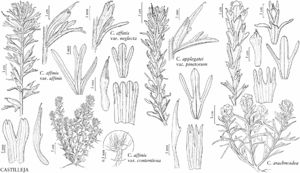Difference between revisions of "Castilleja affinis var. contentiosa"
Leafl. W. Bot. 10: 286. 1966.
FNA>Volume Importer |
imported>Volume Importer |
||
| (3 intermediate revisions by 2 users not shown) | |||
| Line 9: | Line 9: | ||
|special_status={{Treatment/ID/Special_status | |special_status={{Treatment/ID/Special_status | ||
|code=F | |code=F | ||
| − | |label= | + | |label=Illustrated |
}}{{Treatment/ID/Special_status | }}{{Treatment/ID/Special_status | ||
|code=E | |code=E | ||
| Line 17: | Line 17: | ||
|name=Castilleja douglasii var. contentiosa | |name=Castilleja douglasii var. contentiosa | ||
|authority=J. F. Macbride | |authority=J. F. Macbride | ||
| + | |rank=variety | ||
|publication_title=Contr. Gray Herb. | |publication_title=Contr. Gray Herb. | ||
|publication_place=65: 44. 1922 | |publication_place=65: 44. 1922 | ||
| Line 35: | Line 36: | ||
|elevation=0–500 m. | |elevation=0–500 m. | ||
|distribution=Calif. | |distribution=Calif. | ||
| − | |discussion=<p>Variety contentiosa is restricted to the immediate coast in southern San Luis Obispo and northern Santa Barbara counties, where it replaces < | + | |discussion=<p>Variety contentiosa is restricted to the immediate coast in southern San Luis Obispo and northern Santa Barbara counties, where it replaces <i></i>var.<i> affinis</i>. The distinctive branched hairs impart a grayish cast to the plants, and this variety is further distinguished by the commonly pink to pink-purple or purplish red inflorescences. Variety affinis usually has unbranched hairs and reddish to red-orange inflorescences. Transitional plants exist a few miles inland from the coastal populations of <i></i>var.<i> contentiosa</i>. This form has also been confused with <i>Castilleja miniata</i>, from which it differs in numerous characters, including pubescence and leaf and calyx morphologies, as well as with the insular <i>C. mollis</i>, which is distinguished by its largely decumbent stems and broad, rounded, usually unlobed leaves and bracts.</p> |
|tables= | |tables= | ||
|references= | |references= | ||
| Line 44: | Line 45: | ||
-->{{#Taxon: | -->{{#Taxon: | ||
name=Castilleja affinis var. contentiosa | name=Castilleja affinis var. contentiosa | ||
| − | |||
|authority=(J. F. Macbride) Bacigalupi | |authority=(J. F. Macbride) Bacigalupi | ||
|rank=variety | |rank=variety | ||
| Line 58: | Line 58: | ||
|publication title=Leafl. W. Bot. | |publication title=Leafl. W. Bot. | ||
|publication year=1966 | |publication year=1966 | ||
| − | |special status= | + | |special status=Illustrated;Endemic |
| − | |source xml=https:// | + | |source xml=https://bitbucket.org/aafc-mbb/fna-data-curation/src/2e0870ddd59836b60bcf96646a41e87ea5a5943a/coarse_grained_fna_xml/V17/V17_1015.xml |
|genus=Castilleja | |genus=Castilleja | ||
|species=Castilleja affinis | |species=Castilleja affinis | ||
Latest revision as of 19:24, 5 November 2020
Stems: hairs sparse proximally, becoming fairly dense distally, branched. Leaves often ± fleshy. Inflorescences 2–4 cm wide; bracts proximally greenish to dull purplish, distally pink to pinkish purple or pinkish red, sometimes yellow, pinkish white, red, or pale orange, (0–)3–5-lobed. Calyces colored as bracts or paler near base, 15–25 mm. Corollas 25–30 mm; beak subequal with or exserted from calyx, 14–20 mm.
Phenology: Flowering Feb–Aug(–Sep).
Habitat: Coastal scrub, stabilized dunes, canyons.
Elevation: 0–500 m.
Discussion
Variety contentiosa is restricted to the immediate coast in southern San Luis Obispo and northern Santa Barbara counties, where it replaces var. affinis. The distinctive branched hairs impart a grayish cast to the plants, and this variety is further distinguished by the commonly pink to pink-purple or purplish red inflorescences. Variety affinis usually has unbranched hairs and reddish to red-orange inflorescences. Transitional plants exist a few miles inland from the coastal populations of var. contentiosa. This form has also been confused with Castilleja miniata, from which it differs in numerous characters, including pubescence and leaf and calyx morphologies, as well as with the insular C. mollis, which is distinguished by its largely decumbent stems and broad, rounded, usually unlobed leaves and bracts.
Selected References
None.
